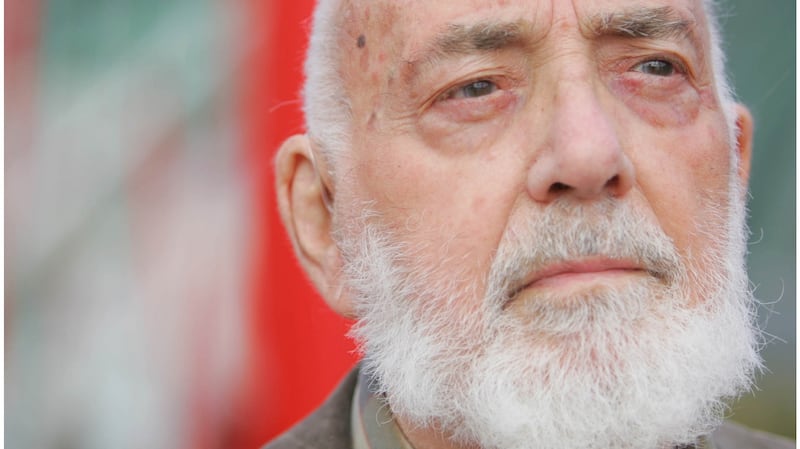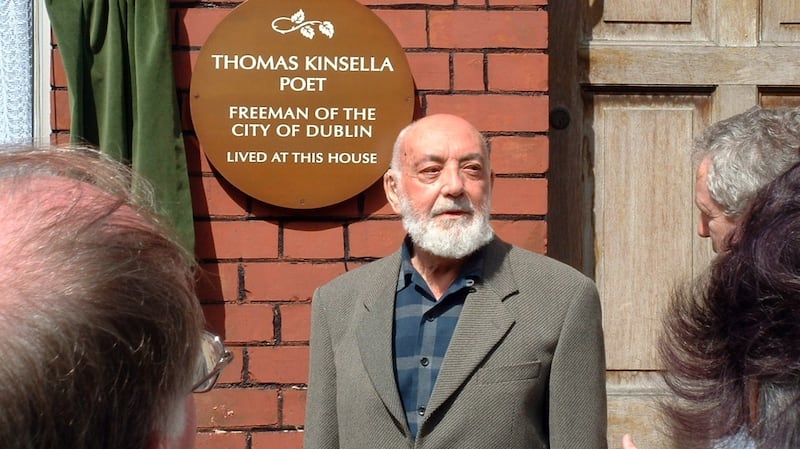Thomas Kinsella is a poet of great restraint and intensity. Much of his poetry is forged by an intelligence and a philosophical exactness, never avoiding the long arc of history nor the anabasis of the self, that epic journey from the coast to the interior of the human experience begun with Nightwalker and continuing, with a late renewal of vigour and intensity which has not abated.
Even in his early traditional verses, formal and elegant, there is no forcing. The rhymes move with an ease and grace that has been described more than once as Audenesque. His break with strict form was made well after he had mastered the craft.
It is hard not to compare the body of his work to that of a composer – his beloved Bach comes easily to mind. He has a composer’s reach and the individual poems seem to me to be part of a greater whole, individual songs and movements in a symphony that is both aural and written. He has perfect pitch and a purity of tone that is almost unique among his Irish contemporaries.

Thomas Kinsella spent 15 years, off and on, working on his translation, gathering, choosing, shaping; he restored what had often been prettified in translation to its original vigour

His immersion in the bardic forms, the very different sounds and constraints of Gaelic verse, has served him, and his readers, well and must have added to his surefootedness in the vertical regions he traversed in the Peppercanister Poems such as Notes From the Land of The Dead, published in 1969, the same year as the Dolmen edition of The Táin, Song of the Night and Song of the Psyche, and continuing through to his great raft of Later Poems.
Many of the poems are concerned with mapping: Dublin’s lanes and streets and canals, and the deeper, psychic cartography of that city. Crucial to this latter is the many ways in which a culture represents itself to itself, of which language is one of the most crucial.
A man with a firm grasp of the dual tradition that Irish poets inherit, no poet was more aware than Kinsella of the cultural and psychological implications for a people of the loss of their language. He was in a position to view the sitauation both before and after the ending of the bardic era, to know that to a greater or lesser degree, Ireland lost its ability to accurately read its own epics and engage with its own culture when the language was lost and gaelic culture declined and broke up. Kinsella dates this at the famine, and certainly that was the last and worst of several deep rifts, chronicled in verse by Daithi Ó Bruadair and Aogán Ó Rathaile. Whenever we date the end of Gaelic culture, his translations of Aogán Ó Rathaile brought to a wide audience the last of the bardic poets in a version worthy of the original and faithful to its strengths. An Duanaire is one of the great literary works of reposession, scholarly, businesslike and an invaluable reference for poet and non-poet alike. It gives us a way back to ourselves in our own language, a code whereby we might find a route alongside and underneath the beauty and mistiness of the Celtic Twilight.

The Táin was published 12 years before Poems of the Disposessed. It was magisterial, rigorous, a work of repossession and composition, rather than re-invention. The task was daunting, archaeological in its reconstruction, a great dig. Before Kinsella there were translations, in part, of parts, of conflicting and incomplete primary texts. Not as sparse as Sappho's fragments, but fragmented nonetheless – the manuscripts annotated, scrubbed out and overwritten, revised and incomplete. In other words, they had all the flaws of any great oral poem written down, reconstructed, perhaps by committee and in a world still Gaelic and culturally healthy, but one which nevertheless had accommodated Christianity and must pay it some lip service in collating the great manuscripts.
There had, of course, been translations and recensions before. Kinsella deals with those fairly in his introduction: he refers the reader to the introduction to Cecile O’Rahilly’s version published by the Dublin Institute for Advanced Studies in 1967 “for a great deal of detailed information on the Táin and its background”.
Lady Gregory's Cuchulain of Muirthemne spares the people of Kiltartan, and Yeats, '"a good deal I thought you would not care about…". She meant urination, sex and slaughter, all told in workaday detail in the original Irish. Victorian sensibility has little use in a reading of Chaucer, much less in a reading of the "earthy" treatment of all natural bodily functions, and of birth and killing and mutilation, that is a feature of early and middle Irish.
Then there was the 1904 translation by Winifred Farady, which the poet tells us "is incomplete and difficult to read with any pleasure, partly because it transmits the flaws of the text (The Book of Leinster) so accurately".

The Táin survived in Irish in a 12th- century manuscript, The Book of the Dun Cow, compiled at Clonmacnoise, and in The Yellow Book of Lecan from the 14th century. Those are the two main manuscripts used by Kinsella, but the origins of the Ulster cycle, it is agreed by most Celtic scholars, are in an oral tradition from at least four centuries earlier, and the "poetic" or "prophetic" speech of the indented pasages may date from two centuries earlier again. Such considerations based on linguistic evidence is the meat and drink of scholarly debate, but of mainly academic interest to the translator, except when they are backed up by useful information about form and custom.
It is in those indented passages that at the poetry happens, in the heightened or prophetic speech, oracular, mysterious and brilliant. Kinsella made no attempt to reconstruct in those passages, and the resulting poems are the powerful links that give the narrative an internal drive. I have valued them since I first read them as ayoung girl, and did not yet know the power of incantation.
Kinsella went for the first chapter of The Táin to The Book of Leinster, since that section serves as a starting point for the movement of armies across the country along the route of the cattle drive, and provides a strong motive for the main action, and Maeve's desire not to be bested by her husband in riches and status. So The Táin starts with a man and a woman in bed, boasting. The story is unlikely to end well.
Thomas Kinsella spent 15 years, off and on, working on his translation, gathering, choosing, shaping, excising for clarity; he rendered the stories with precision and restored what had often been prettified in translation to its original vigour.
In doing so, he provided us with a necessary and clarifying counterpoint to the Celtic Twilight use of the myth cycles in treating with cultural identity. Before Kinsella, there were fragments of the cycle, succesful in places, full of inaccuracies, accrustations and obfuscations.
Kinsella's ear for Irish is as pitch perfect as it is in English, his panoptic vision takes in the whole available manuscript, its various recensions, and makes his choices decisively and with unerring accuracy. He explains clearly in his introduction why he has chosen to begin with the pillow talk section and even without this information, there is an internal structural logic to that beginning, a locating of the start of the action, that is psychically as well as physically accurate. In other words, it is right. There is a beautiful rigour in the finished work, one that reflects the temperature and tone of the Irish language – this rendering is perhaps Kinsella's greatest achievement in The Táin as it works on the level of deep linguistic memory and therefore on the imagination.
I am not qualified to comment on the old Irish texts but I am acquainted enough to know the dangers and some pitfalls: the stylistic accrustations, the riddles rendered entirely meaningless by the passing of time, the linguistic changes and the mishearings and imaginings in writing them down in the first place. And that is before we even begin to consider the rosc and reitoric wars, the scholarly disputes deserving of their own little digressions and recensions.
Thomas Kinsella took an unruly and repetitive bundle of textual scraps and forged it into a clean whole, complete with digressions but never so many as to confuse the reader or to obfuscate the internal sharpness of the story.
It is as if he took in the assembled materials and arranged the narrative into a pattern discerned by his ear and eye, and sculpted the whole into a map of Ireland, the armies moving to and fro across the plains, focusing on individuals who would move the story along and in so doing, give names to the places where great deeds were done:
"I have lived in important places..." Epic by Patrick Kavanagh
Along with the mapping that was central to the epic's dinnseanchas and placenaming, the topography of The Táin still recognisable today, Kinsella provided us with a psychic cartography of a broken world and gave us, in restoring the epic with such literary precision, a map with which we might find our way to the rigour and darkness of the original, a link to the sounds and symbols of our culture in the language that sang its praise and told its stories.
Kinsella's Táin transmits something of the austerity of the Irish, prickly and black as the contorted balckthorn bush, with its sudden explosions of bright blossom. It was in this language the bards expressed what we were, and in rendering it into English Kinsella has bent the language to his purpose and kept it, somehow, in the vernacular.
His Táin is a far cry from the mist and twilight of Yeats' genius visions, closer in tone to the earned truth of his late, great flowering.
He has, as Heaney recognised, given a gift to world literature but he has given those poets who worked in the light of the dual tradition of Irish and English, a way back. And this, for a people as well as a writer, is crucial to the way forward.

Louis le Brocquy's drawings accompanying the text capture the almost Japanese impersonality of the text. I see that my copy was a gift, in 1981, signed "On leaving home again". I have carried it with me on my various journeyings since.
Mary O' Malley's essay on Thomas Kinsella's translation of The Táin was commissioned for the spring 2017 issue of Reading Ireland











